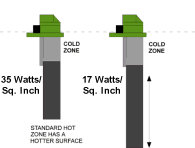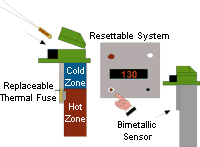Helping Heaters Live Longer
Preventive maintenance is the key to longer heater life...
Over the years, many heaters have been returned as "defective." Unfortunately, most of these heater failures were preventable. Preventive maintenance is the key to longer heater life. Today's electric immersion heaters are designed to regularly perform under harsh conditions. You should expect good heater performance as long as you are willing to take certain precautions. Here are examples of typical failures and the preventive steps that should be taken.
Improper electrical installation will result in poor performance. Electric immersion heaters and temperature controls should be properly wired according to code by a certified electrician. All heater manufacturers provide wiring diagrams with every heater or control shipped. Examine the tags and rating plates found on the heater and control models to verify that they are the correct kilowatts, voltage and amps. Include power surge protection in your installation with the proper size fuse or circuit breaker. Be careful to place metal immersion heaters in tank locations where they will not contact outside power sources such as anodes.
Featured Content
Low liquid levels can lead to serious problems: heater failure or tank fires. Today, heater manufacturers provide low-liquid-level thermal shut-off fuses or sensors with electric immersion heaters. Make sure that the proper heater thermal cut-off sensor is selected in relation to tank operating temperature. Do not bypass thermal fuse connections for expediency. Spare fuses should be kept in supply. If you are going to use a resettable thermal cut-off system, one that employs a bimetallic sensor, make sure your electrician properly installs it. Do not try to mix different brands of heaters and controls with resettable systems because they may not be compatible (Fig. 1).
Always maintain at least two inches of liquid level above the heater's hot zone to avoid over-temperature damage or thermal sensor activation (Fig. 2). Make sure that the area between the heater body and thermal sensor on the heater is kept free of sediment. This could cause the sensor to improperly sense heat and delay heating action. It is also a good idea to back up your heater's thermal shut-off sensor with a liquid level control. Do not rely solely on visual control as a method of backup. People can and do make mistakes.
Build-up or scaling on immersion heaters is one of the leading causes of heater failure. Electric immersion heaters generate high temperatures. Build-up or scaling entraps the heat within the heater and leads to burnout. You can see the dark discoloration on the heater element and in some cases you will see actual holes with melted metal around the perimeter (Fig. 3).
Heaters should be cleaned regularly. Cleaning can be done by scraping metal heaters, chemically dipping the heaters or pressure spraying. Never try to chip off build-up with a hammer since it may damage internal heater components. Another good preventive step for build-up reduction is to use derated electric immersion heaters. Derated heaters provide a cooler surface and thus reduce the rate of build up that is occurring. The heater's "hot zone" is actually stretched to provide this cooler surface. There is a trade off, since it may take more derated heaters to do the same heating job of one standard watt density heater because of physical size differences. For example, a derated 3kW heater will be the same length as a standard watt density 6 kW heater (Fig. 4). Another cleaning tip is to clean the bottom of the tank. Excessive sludge deposits will eventually encapsulate the lower section of your heater's hot zone trapping heat and causing a burnout. Regularly inspect and remove all sediment and build- up to insure longer heater operating life.
Chemical misapplication is another problem. Visual signs of pitting and etching are the usual clues of a chemical attack. I wish that I could simply say, "Don't put quartz heaters in caustic baths and don't put steel heaters in acid baths." However, it is not that simple, because many chemical processes have different additives. Most electric immersion heater catalogs provide a useful chemical application chart. This chart should be considered a guideline. For best results, check with your chemical supplier. He should supply you with a Material Safety Data Sheet (MSDS). This sheet will provide information regarding heater sheath material selection and other useful data. It is usually not a good idea to move heaters from one type of bath to another due to possible chemical differences.
Physical damage to quartz and Teflon® immersion heaters is a concern. Quartz heaters can suffer breaks or cracks from impact or stress. Teflon heaters are abrasive sensitive in that they can be damaged by scrapes or cuts. Therefore, these types of heaters should be carefully handled and a guard should be used. Take care to position them so that they will not come in contact with parts in process or with other tank equipment.
Condensate entering the heater or control is yet another source of concern. Do not mount heaters below the rim of the tank or in an enclosed tank. Lifting a heater by its plastic armored cable could damage it and cause a rupture where condensate will enter. Try not to place the heaters by an exhaust duct or where parts may drip on them. Make sure heaters remain well sealed by inspecting them and re-sealing any loose connections with silicon adhesive.
If you take these preventive steps to ensure longer heater life, you will save both money and lost production time.
RELATED CONTENT
-
Choosing and Troubleshooting Copper Electroplating Processes
Learn more on this inexpensive and highly efficient process.
-
Blackening of Ferrous Metals
The reasons for installing an in-house cold blackening system are many and varied.
-
Cleaning, Pretreatment to Meet Medical Specs ISO 13485 or FDA 21 CFR820
Maximilian Kessler from SurTec explains new practices for industrial parts cleaning, metal pretreatment and decorative electroplating in the medical device industry.






















